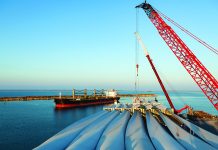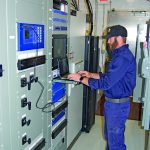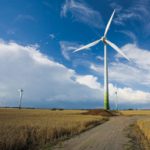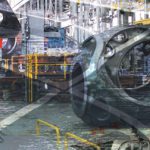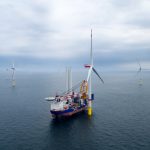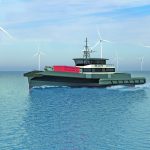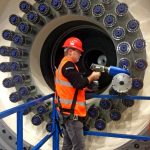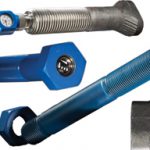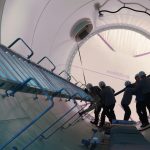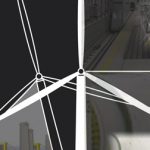Erecting a wind turbine — whether on land or at sea — is literally a monumental task. Turbines are massive machines, so it takes a massive piece of equipment to transform tons of steel and fiberglass into an energy-creating monolith.
Liebherr USA and its sister divisions have been providing the monster cranes needed to construct wind turbines both in Europe and now in the U.S. for decades.
Even though Liebherr had been building cranes for many years, in some ways, it was the wind industry that spurred Liebherr to design and build even bigger cranes than it was using for oil and gas platforms, according to Winston Ziegler, head of sales at Liebherr USA.

Demand brings on innovation
Wind projects started pouring in, and it was necessary to create bigger cranes to accommodate the turbines’ massive size and weight.
“More requirements started coming in,” Ziegler said. “We needed a 1000-ton crane because we needed to install a 3-MW wind tower.”
That was just the beginning as Liebherr later constructed a 1,600-ton crane based off its 400- and 600-ton models. All this began in Europe, but then more projects began kicking off all over the world, according to Ziegler, and these projects were needing bigger and bigger cranes. Some of these projects were in the U.S., and since Liebherr already had a representative in Houston, it was a natural fit to supply equipment to projects being planned in North America.
“As the industry continued to get bigger, it went from 3-MW and 5-MW turbines to where you’re talking 13 MW, which is what it currently is,” he said. “And now, you’re looking at the first 15-MW turbines for offshore, and there is discussion that includes going up to 18, 20, 21 MW, which is just enormous, right?”
To match those growing wind assets, Liebherr has cranes that now can handle 5,000 tons, according to Ziegler.
“With U.S. markets just coming forward to begin planning and building offshore wind, it’s just been a continuation of the market with our existing portfolio as we grow there,” he said.
Land-based equipment
And with the booming offshore wind market, Ziegler points out that Liebherr has been supplying land-based equipment for many years as well.
“Land-based equipment in the U.S. is already quite present,” he said. “We have an Omaha crane, and we have very large crawler cranes. That and other equipment is already servicing existing operations in the U.S.”

A challenge that Liebherr has been solving is having the proper equipment available at ports to handle large blades and other equipment, but Ziegler said Liebherr has constructed special 500-ton cranes that can lift heavy, high-vertical loads, but those cranes can be developed to lift 2,000 and even 3,000 tons.
“It depends on how big customers want to go,” he said.
For that reason, Liebherr’s constant growth in the industry has been dictated by customer needs, according to Ziegler.
“We have grown as the largest crane manufacturer, but it wasn’t a big goal,” he said. “Our large portfolio of cranes has been a natural growth over the decades because it just focused on those customers, and we focused on reinvesting back into the parts and the facilities.”
Many of the cranes Liebherr makes are used on ships, and those ships are also a part of Liebherr’s standard operating procedure, according to Ziegler.
“We supply the ship cranes for those vessels,” he said. “We used to do up to 450 tons, but a big portion of those shipping lines are for 250-ton use, which is the bread and butter for them. But we have two 800-ton cranes coming out later this year that will be going on vessels for the wind and solar industry. And there are discussions for a 2,000-ton model.”
Family owned and operated
A large part of what makes Liebherr such a respected name in the construction sector is how it treats its employees as well as its customers, according to Ziegler.
“We’re 100 percent privately owned by family, and they really cater to still being a family-owned company,” he said. “They’re very involved with their employees and with their customers. And as the third generation that’s taken over now, they’ve really put impetus on reinvesting back into the company — reinvesting back into the factories and service stations and its products and also the employees. They don’t have lavish lifestyles, so a lot of that money flows back into the company, to its divisions, to R&D. And so along with developing the cranes, some of that labor is part of Liebherr’s own in-house electrical refactoring. We make our own switch gears and electric modules. We’re one of the few manufacturers that has that, so when you buy a Liebherr crane, you’re buying Liebherr electronics.”

With that continual investment into R&D, Liebherr is advancing its cranes and other equipment by modifying what powers them, creating electrical components and electric editions, according to Ziegler.
“The whole thing is becoming more electrified,” he said. “We’re seeing that more in our products. We already have that in our 800-ton mobile helper crane. That’s a fully electric ship crane. More of these products are used in offshore. That’s one of those cranes that will be going fully electric as well. We see more of that. Hydrogen is another potential alternative. Let’s say when you’re installing a wind turbine in Lancide. There’s no power there compared to, say, Idaho. So, we’re looking to other forms there because you still need that power source that keeps you mobile.”
Customer needs
Being able to meet customers’ needs comes in many forms, according to Ziegler.
“If it’s an existing job with existing equipment, obviously that will come to service,” he said. But if the equipment doesn’t exist yet, then intense development begins to come up with a solution. That development could be six months or even 10 years, depending on what the needs are, according to Ziegler. That type of development was what made Liebherr’s most recent addition to the wind-energy industry such a milestone. Liebherr’s 5,000-ton crane and its use in offshore installations is the result of that innovation.
“That’s pretty significant,” Ziegler said. “It’s just enormous and fascinating.”
Growing with the industry
As the industry continues to grow, Ziegler said Liebherr will be an essential part of that growth.
“You’re still going to need either crane replacements, or customers will get new business, and they will need new cranes; they get new job sites, or they have new shipping lines,” he said. “For wind offshore, firstly I’m curious to see how it develops and how government support develops. That’s what we’re seeing at the cusp of it all.”
During this expansion, Ziegler said he sees support growing in the ports particularly with the larger crawler cranes, mirroring the growth that’s been seen in Europe.
“That could happen there,” he said. “The crawler cranes could expand more, even though right now there are probably a few in the U.S. But if the window should develop some more, you could see a few more big crawler cranes coming to the market. But also, just in general, with the mobile helper crane market, our crawler cranes will continue to be very much in demand.”
And with that development, new innovative and sustainable methods to power the machinery will continue to be at the forefront of Liebherr’s contribution to the expansion of wind-energy — and more — across the globe.
“I think we’ll see how much hydrogen will come along; let’s see how much that really demands,” Ziegler said. “Obviously, the electrification will continue.
That’s just the thing now, so that will officially happen at least in the next two or three years, and, probably, we’ll see it before that.”
More info www.liebherr.com


















